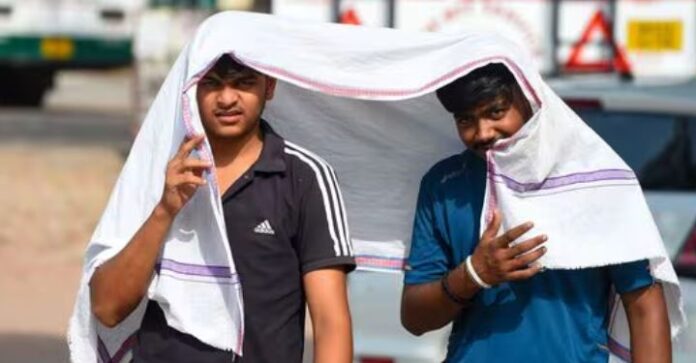India is currently experiencing a dramatic divergence in weather patterns as its capital, Delhi, suffers under a relentless heatwave, while southern tech hub Bengaluru prepares for days of heavy rainfall. The India Meteorological Department (IMD) has issued simultaneous alerts in both regions — a rare and telling indication of the climate volatility impacting the country this season.
Delhi’s Heatwave: Temperatures Climb Past 45°C
As of June 11, Delhi has been placed under a Red Alert due to extreme heatwave conditions, with temperatures soaring above 45°C in several parts of the city. Areas like Aya Nagar recorded highs of 45.2°C, while Safdarjung, the city’s base station for official readings, hit 43.3°C. These figures alone are alarming, but when humidity is factored in, the ‘feels-like’ temperature or Heat Index has breached 52°C — a dangerously high level for human health.
The IMD warns that these conditions are likely to persist until at least June 13, after which isolated thunderstorms and patchy rainfall may offer some respite. The oppressive heat is attributed to dry northwesterly winds, strong sunlight, and the lack of cloud cover — all hallmark features of a typical North Indian summer but made worse this year by delayed monsoon advancement.
Bengaluru: Monsoon Rainfall Brings Relief and Risk
On the other end of the spectrum, Bengaluru has been drenched in monsoon showers this week, with more heavy rain expected in the days ahead. The city recorded 21°C as the minimum and 28°C as the maximum temperature on June 11, with sporadic downpours bringing much-needed relief from the earlier summer heat.
However, the IMD has warned of heavy to very heavy rainfall in parts of south Karnataka, including Bengaluru, driven by monsoon currents from the Arabian Sea and the Bay of Bengal. Residents have been urged to stay alert for potential waterlogging, traffic snarls, and the risk of falling trees or weakened infrastructure due to continued wet conditions.
IMD’s Dual Alerts: Red in the North, Orange in the South
The IMD’s red alert in Delhi indicates the highest level of severity, urging citizens to stay indoors during peak hours, avoid strenuous outdoor activity, and ensure hydration. The orange alert in Bengaluru, while less severe, calls for preparedness and caution due to the possibility of urban flooding and associated hazards.
This dual warning system highlights the stark regional contrasts in India’s climate, as well as the IMD’s growing role in not just predicting but managing the societal impacts of weather extremes.
Public Response and Government Action
In Delhi, schools have issued advisories limiting outdoor activities, and hospitals are seeing a rise in patients with heatstroke, dehydration, and exhaustion. Water distribution points have been set up in several neighborhoods, and the Delhi government is advising vulnerable populations — especially children, the elderly, and outdoor workers — to avoid sun exposure.
Meanwhile in Bengaluru, municipal workers are on standby to respond to waterlogging complaints, clear fallen branches, and manage traffic during peak rainfall hours. The city’s civic body, BBMP, has urged residents to report any blocked drains or flooded areas via their emergency helplines.
How to Stay Safe: IMD’s Advice for Both Cities
For Residents in Delhi:
- Stay indoors between 11 AM and 4 PM.
- Wear loose, light-colored clothing.
- Drink at least 2–3 liters of water per day.
- Avoid caffeine, alcohol, and spicy food that can dehydrate the body.
- Use fans, coolers, or air-conditioning where available.
- Watch for signs of heatstroke: dizziness, nausea, high body temperature, and rapid pulse.
For Residents in Bengaluru:
- Avoid driving or walking through flooded roads.
- Unplug electrical appliances during thunderstorms.
- Ensure proper drainage in and around the house.
- Keep emergency kits ready with essentials.
- Follow real-time alerts from local weather stations and BBMP updates.
Experts Weigh In: Climate Change a Possible Factor
Meteorologists and climate scientists point to the increasing frequency of such extreme weather events as signs of broader climate shifts. Dr. Ramesh Goyal, a senior meteorologist at the Indian Institute of Tropical Meteorology, noted:
“The simultaneous occurrence of intense heatwaves in one region and excessive rainfall in another is indicative of a warming climate. We’re seeing the destabilization of typical weather cycles, especially during transitional periods like pre-monsoon.”
Experts warn that unless measures are taken to improve urban planning, build heat-resilient infrastructure, and ensure efficient water drainage, Indian cities will struggle to cope with future weather extremes.
Looking Ahead: Monsoon Watch
The IMD has predicted that the monsoon will progress steadily over the next week, likely reaching central India by mid-June. While this could eventually bring relief to Delhi and further intensify rainfall in Bengaluru, the timing and intensity will depend on shifting wind patterns and pressure systems.
For now, authorities in both cities remain on high alert, with emergency services and hospitals operating in full preparedness mode.
Final Thoughts
India’s current weather scenario underscores the need for greater climate adaptability and awareness. From Delhi’s blistering heatwave that endangers lives, to Bengaluru’s downpours that disrupt daily life, the contrast couldn’t be more dramatic — or more urgent.
As these patterns become more frequent and intense, staying informed through reliable channels like the IMD and local authorities becomes not just a recommendation, but a necessity.

